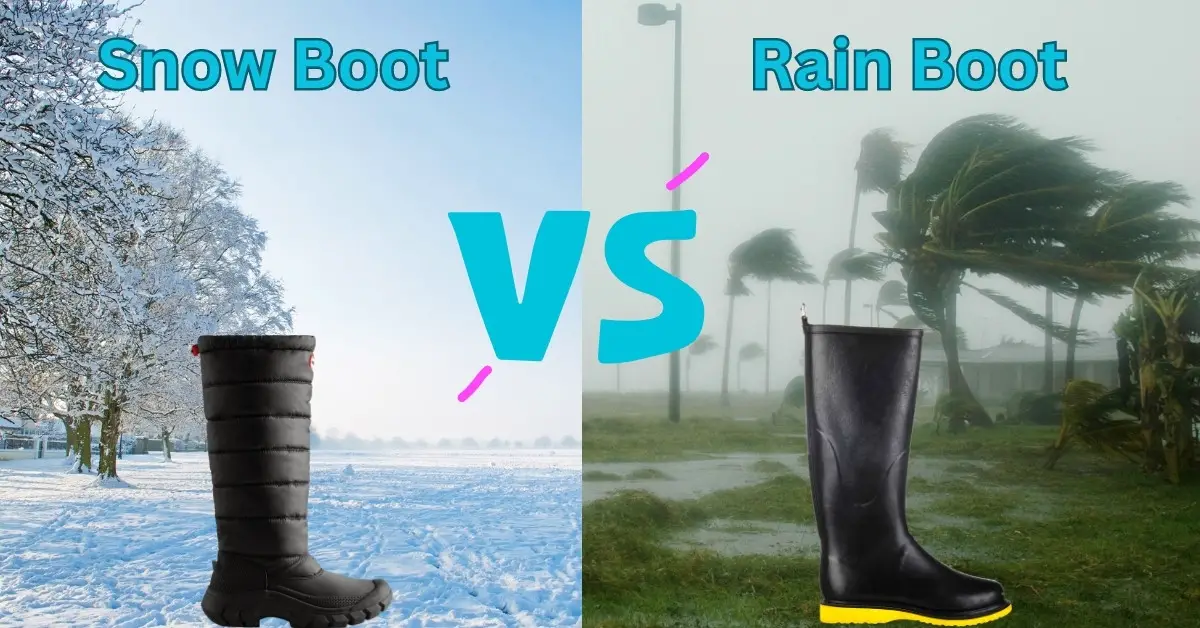Snow Boots Vs Rain Boots
Two popular options for winter footwear are snow boots and rain boots. While both types of boots are designed to keep your feet dry, they have some differences that may make one more suitable than the other depending on your needs. In this article, we will take a closer look at snow boots and rain boots, and compare their features to help you decide which one is the best choice for you.
What are Snow Boots?
Snow boots, as the name suggests, are designed for use in snowy conditions. They are typically heavier and more insulated than rain boots, with features that help keep your feet warm and dry in cold and snowy weather. Snow boots are usually made with a waterproof upper and thick insulation to provide warmth and protection from the elements. They may also have a thick, lugged sole for added traction on slippery surfaces.
What are Rain Boots?
Rain boots, also known as wellies or Wellington boots, are designed to keep your feet dry in wet weather. They are typically made with a completely waterproof rubber or synthetic material, allowing you to walk through puddles and rain without getting your feet wet. Rain boots usually have a thinner sole than snow boots.
Comparison of Snow Boots and Rain Boots
When deciding between snow boots and rain boots, it’s important to consider the specific features of each type of footwear. Here are some key differences between the two:
Insulation
Snow boots are designed to provide warmth in cold weather, so they typically have more insulation than rain boots. They may be lined with materials like fleece, fur, or Thinsulate to keep your feet warm in sub-zero temperatures. Rain boots, on the other hand, may not have any insulation at all, as they are designed to keep your feet dry rather than warm.
Traction
Snow boots usually have a thick, lugged sole that provides traction on slippery surfaces like ice and snow. The sole may also be made of a material that stays flexible in cold temperatures to prevent slipping. Rain boots may have a less aggressive sole, as they are primarily designed for walking on wet surfaces rather than snow and ice.
Materials
Snow boots are usually made with heavy-duty materials like leather, nylon, or synthetic materials like Gore-Tex, designed to withstand cold and wet conditions. Rain boots are typically made with rubber or synthetic materials like PVC that are entirely waterproof.
Style
Snow boots and rain boots come in various styles, but there are some differences in their overall look. Snow boots may have a bulkier, more rugged appearance, with features like fur trim or buckles. Rain boots may be more streamlined and classic in style with a smooth rubber or synthetic upper.
Waterproofing
Snow boots (usually) and rain boots are designed to be waterproof, but they may use different methods to achieve this. Snow boots may have a waterproof membrane or coating that keeps water out, while rain boots are usually made with a single piece of waterproof material like rubber.
When to Wear Snow Boots vs. Rain Boots
The decision to wear snow boots or rain boots will depend on the specific weather conditions and your planned activities. Here are some general guidelines:
Snow Boots
Snow boots are best suited for cold, snowy weather. They provide insulation to keep your feet warm and traction to prevent slips and falls on snow and ice. You may want to wear snow boots for activities like walking in the snow, or shovelling snow. If you live in a cold climate with frequent snowfall, snow boots are a must-have for staying warm and comfortable during winter.
Rain Boots
Rain boots are designed for wet weather, whether it’s rain or slushy snow. They are completely waterproof, making them ideal for walking through puddles or wet grass. Rain boots are a good choice for activities like gardening, walking or playing in wet conditions or for daily wear when it’s rainy outside.
Tips for Choosing the Right Boots for You
When selecting snow boots or rain boots, consider the following factors to ensure that you choose the best option for your needs:
Climate: If you live in an area with cold, snowy winters, snow boots are a must-have. Rain boots will come in handy year-round if you live in a rainy climate.
Activities: Think about the activities you plan to do while wearing your boots. If you’ll be hiking or walking on slippery surfaces, snow boots with good traction are a must. If you are commuting to work in the rain, rain boots that are easy to slip on and off are a good choice.
Style: Both snow boots and rain boots come in a variety of styles, so choose a pair that fits your personal style and preferences.
Fit: Make sure to try on boots before you buy them to ensure a comfortable and secure fit. You may want to consider wearing thick socks when trying on snow boots to ensure a proper fit.
How to Care for Your Boots
Proper care will help extend the life of your snow boots or rain boots. Here are some tips to keep your boots in good condition:
Clean your boots after each use, especially if they’re muddy or wet. Use a damp cloth to wipe away dirt and debris.
Store your boots in a dry place away from direct sunlight. Avoid storing them in damp or humid areas, as this can cause mold or mildew.
Apply a waterproofing spray to your boots as needed to help maintain their waterproofing.
Rain boots and snow boots comparison table
| Feature | Rain Boots | Snow Boots |
|---|---|---|
| Primary Purpose | Keep feet dry in wet or rainy conditions | Keep feet warm and dry in snowy, cold conditions |
| Insulation | Usually minimal or none, focused on waterproofing | Insulated, designed to retain warmth |
| Material | Typically made of rubber or PVC | Usually made of leather, nylon or synthetics with a waterproof membrane |
| Traction | Moderate, suitable for wet surfaces | Excellent, designed for slippery, icy, or snow-covered surfaces |
| Height | Low cut (clogs) to tall | Ankle to tall |
| Closure | Slip-on, sometimes with adjustable straps | Lace-up, Velcro, or zipper closures for a secure fit |
| Style | Often bright colours and fun patterns | Generally, more subtle colours, focused on functionality |
| Weight | Varies from lightweight to heavy | Usually heavier due to insulation and thicker materials |
| Liners | Rarely included or removable | Often include removable liners for added warmth and easy drying |
| Price Range | Cheap to expensive | Moderate to expensive |
Conclusion
Both snow boots and rain boots are designed to keep your feet dry, but they have some key differences in terms of insulation, traction, materials, style, and waterproofing. When choosing between snow boots and rain boots, consider your climate, activities, style preferences, and fit. With the right pair of boots, you can stay warm, dry, and comfortable during even the coldest and wettest winter weather.
FAQs – Rain boots Vs Snow Boots
- Can you wear snow boots in the rain?
Yes, snow boots can be worn in the rain
- Are rain boots good for snow?
Rain boots can be worn in light snow, but they may not provide the same level of insulation or traction as snow boots.
- How do you store snow boots?
Store snow boots in a dry place away from direct sunlight, and avoid storing them in damp or humid areas.
- Can you wear snow boots for hiking?
Good quality snow boots with good traction are a good choice for hiking in cold and snowy conditions.
- Can rain boots be worn in the winter?
Rain boots can be worn in the winter, especially if it’s wet and slushy outside. However, they may not provide enough insulation to keep your feet warm in very cold temperatures.
- How often should you waterproof your boots?
The frequency of waterproofing depends on how often you wear your boots and the conditions they are exposed to. As a general rule, it’s a good idea to apply a waterproofing spray once every few months
- What is the difference between snow boots and winter boots?
Snow boots are designed specifically for cold and snowy conditions, while winter boots may be more versatile and suitable for a wider range of temperatures and conditions.
- Can you wear rain boots with jeans?
Yes, rain boots can be worn with jeans for a casual and practical look.
- Can you wear socks with rain boots?
Yes, socks can be worn with rain boots to provide additional warmth and comfort.
- How can you prevent snow from getting into your boots?
Tuck your pants into your boots or wear gaiters to prevent snow from getting into your boots. You can also choose boots with a higher shaft that covers more of your leg.
- Can snow boots be worn for fashion?
Yes, snow boots are available in various stylish designs and can be worn as a fashion statement during winter.
- Can you wear rain boots in the summer?
Yes, rain boots can be worn in the summer during rainy or wet weather.


